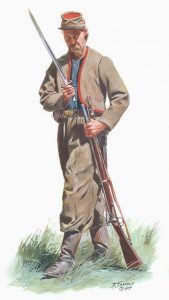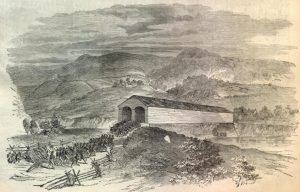Lew Wallace Secures the B&O– For the First Time (Pt. 1)
Lew Wallace, the Hoosier lawyer-turned soldier, readied his command for its move. His objective was a vital connection of the Baltimore & Ohio Railroad whose trains were badly needed to transport material and manpower. Wallace wrote later, “The need of the Baltimore & Ohio Railroad for purposes of supply and communication was imperative.” He continued, “Little did I suspect that its rescue was to fall to me, my first achievement.” Wallace gathered his troops and set off. This story may sound like it takes place in the summer of 1864, with the leadup to the Battle of Monocacy, but in fact, it takes place three years earlier, among the war’s first days.[1]
Wallace was a colonel in command of the 11th Indiana Infantry, whose soldiers wore distinct gray zouave jackets. He had strong political connections with the state’s governor Oliver Morton, but the adrenaline fueled by the war’s opening days had started to wane as late spring approached early summer. Wallace and his Zouaves were posted near Cairo, Illinois, and Lew, ever a man spoiling for a fight, was growing bored of the duty there.

He used more of his connections, including his brother-in-law, a U.S. Senator, to get a more action-filled post for the 11th Indiana. In early June, Wallace got his wish. He and his Hoosiers were ordered to report to Cumberland, Maryland and protect the Baltimore & Ohio’s bridges there. Making their way east, the Zouaves passed through Indianapolis and Cincinnati, Ohio before arriving in Cumberland on June 10.[2]
On his way to the town Wallace learned it was “a Union city heavily sprinkled with mischievous secessionists.” It had a population of about 4,000 people, and it was located along the north branch of the Potomac River. Less than ten miles north lay the Pennsylvania border, and just across the Potomac was secessionist Virginia (though now West Virginia). But what made Cumberland so important were those bridges of the Baltimore & Ohio. At Cumberland the B&O took a sharp turn south, and many in Washington feared the repercussions if the rebels were able to choke off the supplies heading east from Ohio. To be fair, Confederate forces already controlled Harpers Ferry, effectively shutting down the B&O. But plans were in the work for the Federal forces under Maj. Gen. Robert Patterson to capture Harpers Ferry, and the last thing Federal officials needed was damage to the railroad’s tracks further west.[3]

The Indianans set up camp as Cumberland’s townspeople “flocked to see ‘the Hoosiers in the big gray breeches.’”[4] Wallace rode around the town with its mayor, getting the lay of the land and seeing what his responsibilities were. And those responsibilities were clearly laid out in orders waiting for Wallace when he arrived. With the 11th Indiana’s arrival at Cumberland, the regiment now answered to Maj. Gen. Robert Patterson, overseeing operations in the western parts of Virginia and the tip of the Shenandoah Valley. In a letter dated June 6, Patterson instructed the colonel to 1) secure “the bridges over the Potomac,” 2) “Gather as much reliable information as possible of the disposition of the people of Maryland and Virginia in that vicinity,” 3) “Encourage the Unionists in disaffected regions to band together for self defense,” and finally, 4) “Should you gain information of the gathering. . . of armed bodies of men not too powerful to be overcome. . . capture or rout them by surprise.”[5]
Wallace welcomed those roles, but especially the last one. He was a man who, time would tell, genuinely enjoyed the thrill of combat. And here was his first chance to close with the enemy. When Wallace was twenty years old, he had served in the Mexican War, but had not seen any fighting. Now, though, just a stones throw from the rebellion, Wallace jumped at the opportunity.

Just shy of thirty miles south of Cumberland sat the town of Romney, with a meager population of about 500 people. But Romney had “an importance far beyond its humble size,” writes historian Peter Cozzens. The Northwest Turnpike ran through the town to Winchester, “key to the Confederate defense of the Lower Shenandoah Valley.” From Romney Wallace could also gather forage and crops for his forces, and finally (and more tangential to his mission), Romney “commanded the sixty-mile length” of the B&O through the area. To Wallace, a good defense was a strong offense; if he was to protect the bridges at Cumberland one of the easiest ways to do that was to attack Romney. He made plans just the day after arriving to head out on his sortie.[6]
Eight companies of the 11th Indiana loaded onto B&O cars on June 11, with two remaining to hold the line at Cumberland. Wallace’s plan was to ride the line south to a town called New Creek, dismount, and then march overland to Romney. That march brought the infantry through mountains, which Wallace described as “very fatiguing and rough, leading along high bluffs and narrow passes[.]” The Zouaves pulled up in front of Romney by 8:00 a.m., and their Colonel scanned the area.[7]
In front of the regiment was a bridge that crossed a branch of the Potomac River. Crossing the bridge would put the regiment beneath a bluff leading into town. To capture Romney Wallace’s men needed to take both the bridge and the bluff. On the bluff, Wallace could see two field pieces, “planted so as to sweep the road completely.”[8]
As Wallace’s men closed in, a mounted picket of Confederates fired on them, wheeled, and galloped back for Romney. The Indianans returned the fire, and according to one soldier, killed a Confederate who “was seen to fall and slide down the side of the mountain about twenty feet, when his body lodged against a tree.”[9]
Alongside the two guns, the Confederate foe facing Wallace’s men were three companies of infantry that would one day become a portion of the 33rd Virginia Infantry. Those Confederates opened fire as Wallace’s men stormed towards the bridge. Bullets kicked at the feet of the soldiers as they crossed, but none hit. The only casualty–such as it was– was an odd ricochet. Company A led the way, headed by Capt. Robert S. Foster and a bullet “struck between his feet, glanced and struck Sergeant [Moses] Grooms upon the suspender buckle, stunning and bruising him considerably, but not otherwise hurting him.” The broken buckle proved to be Wallace’s only loss.[10]

With the Hoosiers across the bridge, the Confederates broke. They quickly limbered the two field pieces and bolted through the streets of Romney. Wallace’s men followed on their heels, but the Confederate retreat soon outpaced them, leaving behind their small handful of casualties. Left with Romney as their prize, the Zouaves set out to gather up their captured equipment. They found “horrible old flint lock muskets and rifles,” and “two or three wagon loads of provisions, tents, uniforms, etc.” Besides the martial supplies, the Indianans also delighted in capturing as many small rebel flags as they could, and soon, “Each one wore the flags or such uniform as they could get, around their bodies[.]” While the soldiers gathered the captured supplies, the town’s black population came out and “met us with the cheeriest welcome, and in time incredibly short there was not a hungry man in the regiment,” Wallace wrote. The soldiers gorged on “bread, butter, milk, and eatables as they had on hand.”[11]
It was soon time to return to Cumberland. The Hoosiers retraced their steps back to New Creek, climbed back aboard the B&O cars, and headed back to Maryland. They arrived back into camp with stories to tell shy of midnight.[12]
Though tiny in retrospect, Wallace’s raid on Romney threw a cog into the Confederates’ plans for the Shenandoah Valley. From his headquarters at Harpers Ferry, Joseph Johnston feared Wallace’s force was just the tip of the spear, and worried what a larger force could do stabbing at the underbelly of his forces. By June 15, Johnston began pulling out of Harpers Ferry and moving towards Winchester. While leaving Harpers Ferry provided a chance for Federal officers to better formulate their decisive attack into Virginia, it in turn posed its own set of problems to Wallace.[13]
The chief concern Colonel Wallace faced was the prospect of thousands of Confederates closing in and getting considerably closer to Cumberland. Whereas before Wallace just faced a few companies worth of half-trained infantry, now it seemed like Johnston was bringing his soldiers to within striking distance of Wallace’s tiny regiment of Zouaves. Wallace worriedly wrote to Gen. Patterson, “I have positive information that there will be four thousand rebel troops at or in Romney to-night, who swear they will follow me to hell but [that] they will have me.”[14]
Those concerns were heightened even more on June 19. Two regiments of Confederate forces, the 13th Virginia and 3rd Tennessee Infantry, both under the command of Col. A.P. Hill, closed in on New Creek. The same place from where Wallace had launched his attack against Romney now faced its own attack. Hill sent the Tennesseans in, and they, by the end of the day, attacked one of the B&O Railroad bridges crossing the Potomac River.[15]

Hill’s strike at New Creek caused little lasting damage, but led Wallace to telegram more Federal officers, this time more persistent in asking for help. Finally one of those telegrams made its way to General of the army, Winfield Scott. Having no other troops to send, Scott wired Governor of Pennsylvania Andrew Curtin, explaining the situation. Scott instructed Curtin, if possible, to send two regiments to Wallace’s aid.
Those two regiments were the 5th and 13th Pennsylvania Reserves. They received their orders on June 21 and set out from their camps around Harrisburg. A soldier in the 13th– also known as the Bucktails– wrote that they “hailed with delight the order to move.” The Pennsylvanians “bade good bye to Camp Curtin and were loaded on box cars on the Pennsylvania Railroad[.]”[16]
For Lew Wallace, help was on the way.
______________________________________________________________
[1] Lew Wallace, An Autobiography, Vol. 1 (Harper & Brothers Publishers, 1905), 277.
[2] Ibid; Gail Stephens, Shadow of Shiloh: Major General Lew Wallace in the Civil War (Indianapolis: Indiana Historical Society, 2010), 23.
[3] Wallace, Vol. 1, 279.
[4] Wallace, Vol. 1, 283.
[5] Official Records of the Union and Confederate Armies in the War of the Rebellion (OR) Ser. 1, Vol. 2, 668.
[6] Peter Cozzens, Shenandoah 1862: Stonewall Jackson’s Valley Campaign (Chapel Hill: UNC Press, 2008), 11; OR, Ser. 1, Vol. 2, 123.
[7] OR, 1, Vol. 2, 123.
[8] Ibid.
[9] Harpers Weekly, July 6, 1861.
[10] The Evansville Daily Journal, June 19, 1861.
[11] Ibid; Wallace, Vol. 1, 289.
[12] OR, Ser. 1, Vol. 2, 124.
[13] Edward G. Longacre, The Early Morning of War: Bull Run, 1861 (Norman: University of Oklahoma Press, 2014), 118.
[14] OR, Ser. 1, Vol. 2, 689.
[15] Ibid., 131.
[16] John Bard, History of the Old Bucktails (Clearfield County Historical Society, 2013), 4.
Romney, Fort Donelson, the Defense of Cincinnati, Monocacy… there was a lot to like about Lew Wallace. Thanks for providing this excellent rendition of the early foray into Virginia.